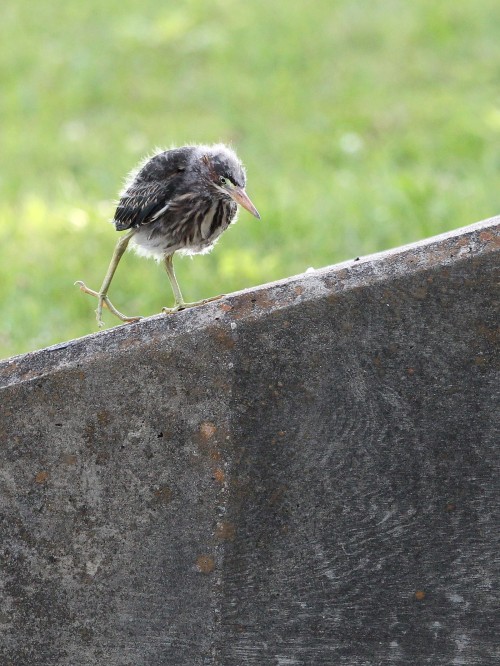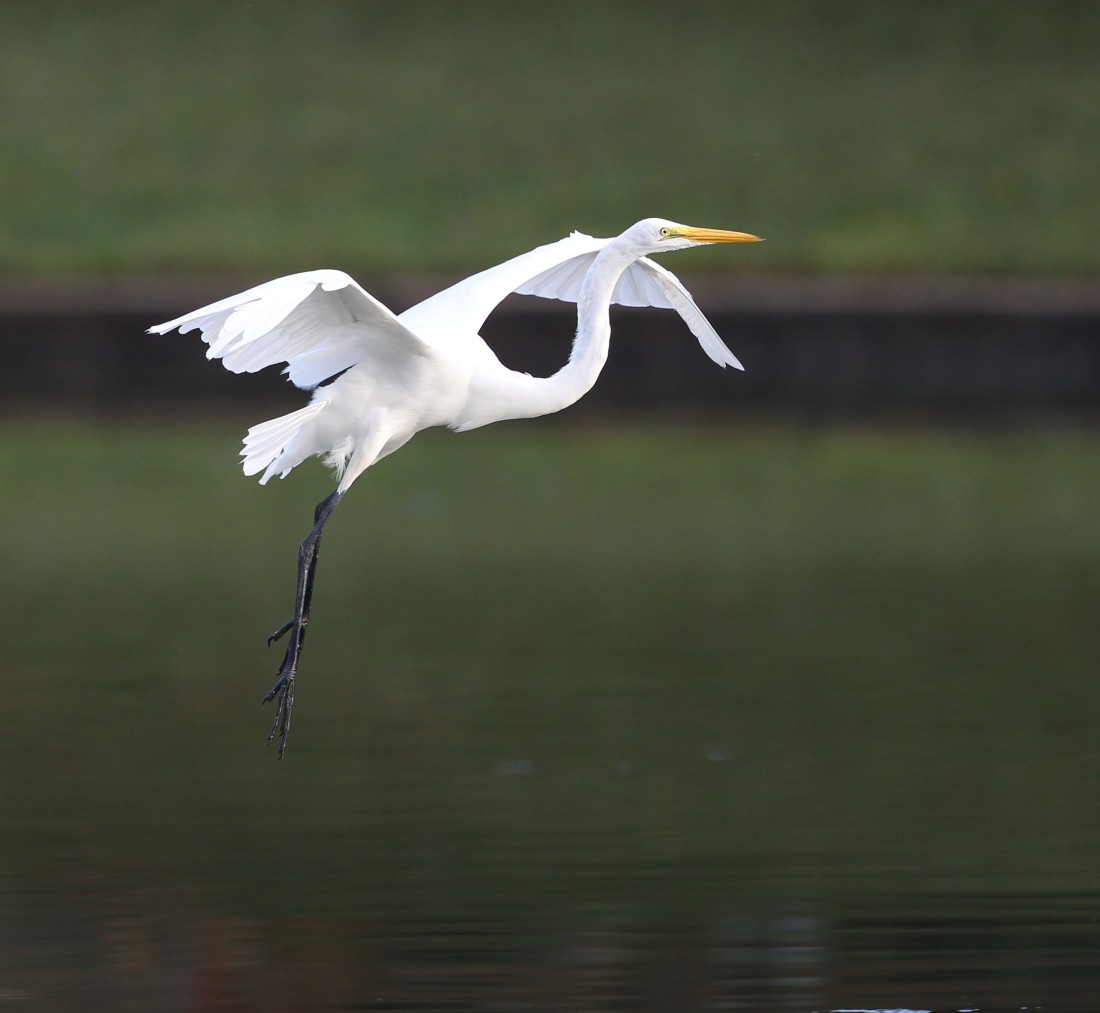I mentioned in my last blog that fall migration was well underway and that a lone juvenile Green Heron lingered at Lakeside Park in Chesapeake, VA. I then imagined the young bird “flying solo to coastal Venezuela.”
Later, I got to thinking about a photo I’d taken in May: a photo of a Green Heron fledgling that was presumably a different Lakeside Park bird. The bird had just left its nest and was busy exploring its new surroundings. The photo, one of my favorites, captures it peering over the edge of the bulkhead. Now, just imagine this juvenile flying solo to coastal Venezuela, perhaps by way of Cuba or the Cayman Islands.

For that matter, imagine these 2 young Killdeer, captured back in April, doing pretty much the same thing. Though Killdeer are “permanent residents” of Virginia, some do migrate medium distances. These 2, each alone, may have already departed for Florida!

Birds Inspire the Imagination
Birds inspire the imagination, don’t they? I’ve noted many times that that’s true of birds in flight, especially raptors in flight. If you’ve ever seen the British drama, Kes, you’ll recall Mr. Farthing’s words regarding the Common Kestrel that Billy, his young student, was training: “When it’s flyin’, there’s something about it makes you feel strange.” “Strange,” here, means “wonderstruck,” if not “like you’re witnessing something supernatural.” He went on to say, “Have you noticed how quietly we’re speaking? As if we’re frightened to raise our voices, a bit like shouting in church.” Well, folks look at bird migration the same way. Consider again Russ Ruffing’s moving reflections at the end of “Meanwhile the Wild Geese.” He wrote, “I am absolutely intrigued with the movement of birds around our planet.”
A Perfect Segue
A reader in Maryland sent me a message shortly after I’d published my last blog, “A Few Thoughts on Birds and Bird Photography.” He asked me to describe my camera, my lens, my camera settings, my shooting mode, where I set the ISO, and so forth. I responded by asking him for an explanation, since describing those things wasn’t something I’d set out to do. A short while later I decided to reread what he’d written and respond as best I could. But he’d deleted his message. Then I got to thinking. Was he asking those questions out of frustration? Was he disappointed I hadn’t provided any answers? I’ll bet he was. So, what I’ll do now is try my best to address his concerns. But before I do, let’s look at a photo I took of a New World raptor, a Black Vulture. As I told someone recently, it’s not often that you get a chance to shoot a vulture flying so close to the ground. Here, it was flying just over the surface of the lake in Lakeside Park.

The Bird Photography Blogs
Now, back to our reader. He asked some good questions. What he likely didn’t know was that I’d already answered some of them in my 2 earlier bird photography blogs: “Bird Photos and Photo Tips at Midyear,” and “More Midyear Bird Photos and Photo Tips.” If you haven’t done so already, please read those 2 blogs together. For one, the second one builds on the first. Also, I made a mistake in the first, which I corrected in the second.
Here are the main gear-focused things I touched on in those blogs:
- Camera drive modes: single shot and burst mode (continuous shooting mode)
- Camera autofocus modes: One-Shot (Autofocus-Single or AF-S) and AI Servo (Autofocus-Continuous or AF-C)
- Back button focus
One important takeaway from all that I wrote there is this: I shoot everything with my camera set to AI Servo and back button focus. Using back button focus enables me to easily switch between AI Servo for moving subjects and One-Shot for stationary ones. And even though I began the first blog by stating that I’m using the single shot drive mode more often, that’s not the case. My camera is almost always set to burst mode/continuous shooting mode.
Gear Talk
Aside from the above, I also mentioned that I carry a Canon EOS-1D Mark IV with a Canon EF 500mm f/4 II lens attached into the field. The Mark IV is a crop frame DSLR camera. It’s old tech, but I like the ease of use of old tech, provided it still allows me to take good photos. Sometimes I carry a full frame Canon EOS-1D X DSLR instead. Occasionally, I’ll attach a Canon Extender EF 1.4X III to my lens for a little extra reach. David Molnar, a self-styled “photography mentor,” has written a helpful article on crop frame and full frame sensors. In the article, he also recommends various crop fame and full frame cameras. His article is a good read, and I like his recommendations. Now, before we get too carried away with gear talk, keep an important line from David’s piece in mind: “Creating a ‘good’ photograph has a lot more to do with the skill of the photographer than the equipment they choose.” Quality gear is important, but never discount the importance of fieldcraft and proper photographic technique.
Shooting Modes
One thing I haven’t mentioned so far is shooting or exposure modes. Taking pictures is all about capturing images that are well-exposed or well-lit, so shooting mode selection is pretty darn important. I almost always use Aperture Priority or Av (“A” on Nikon cameras). Aperture Priority is considered the “gold standard for bird photographers,” and for good reason. It’s a semi-automatic mode that enables the photographer to control both the light-gathering ability of a lens and the depth of field or area of sharpness in an image. I was able to capture the Black Vulture above in early morning light because I shot “wide open” or with a wide aperture in Av. I was able to capture the Great Egret below a few minutes later by using the same method.

By shooting in Av, here, I was able to control the aperture, the light-gathering ability, the depth of field, and the rendering of the background. Let me take that a step further. I also, in a sense, was able to control the shutter speed. Shooting wide open—or wider open—allows for faster speeds.
It’s funny. I often say that it’s all about light. And it is. You can’t take pictures without it. But for bird photographers, especially BIF (Birds in Flight) photographers, it’s also all about shutter speed. You can’t capture or freeze birds in flight with slow shutter speeds; it just can’t be done. I captured both the vulture and the egret at speeds of a little over 1/1000 of a second. I always shoot at least this fast when I’m out in the field targeting birds.
And This Just In
We’re going to have to wrap things up. We’ll continue the discussion of shutter speed and shooting modes, and we’ll introduce ISO speed as well, in the next blog. So please stay tuned. Better yet, and if you haven’t done so already—follow the blog!
One quick additional note. I cited Don Mammoser’s Outdoor Photographer article, “In the Neighborhood,” in my last post. You might not have read it as the print is so small. If you skipped it for that reason, please take another look. If you open the PDF file (the link is in the upper left), you’ll be able to read the article comfortably @ 150%. Don covers everything from light to composition to backgrounds and timing. Again—it’s a great read. You might also be interested in seeing some of his work at donmammoserphoto.com. Click on “Gallery” at the top of the page.
Quip, Question, Quote
I mentioned the Top Ten 1969 British film, Kes, above. It’s a must-see film about a troubled boy who found purpose and whose life was changed when he discovered and began to train a Common Kestrel he affectionately named “Kes.” The film’s story is based on the real-life story of Richard Hines, who recently wrote a book about his experiences: No Way But Gentlenesse: A Memoir of How Kes, My Kestrel, Changed My Life. Though I haven’t read it, it appears to be a must-read book. Here’s an interesting and thought-provoking excerpt from Conor Jameson’s great review in British Birds:
Like Richard I’m interested in the importance of birds to people, and fascinated by the particular significance of birds of prey. I think Kes has played a huge role in creating this place for birds and birds of prey in our lives, our culture, and our sense of selves, of justice, of connection to natural environment made difficult and sometimes impossible for some.
And then later on in the review, he writes this: “Falconer or just plain old bird enthusiast, if you can love something that isn’t giving very much love in return, perhaps that is the greatest love, and is part of the particular resonance of Kes, and totemic power of birds generally (emphasis mine).”
The egret looks so graceful in that picture and the vulture is fascinating to behold.
LikeLike
Hi, Andrea, Thanks for reading and for your comments. I love the little fuzzball heron photo, too. I think it had left its nest the night before. It really is one of my favorite photos. Glad you enjoyed the tips! Dave
LikeLiked by 1 person